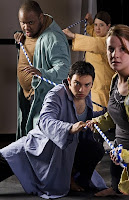
CPT: ‘TWO PLAY BY GAO XINGJIAN,’ well staged, but not for everyone
Anyone seeing ‘TWO PLAYS BY GAO XINGJIAN,’ which is now on stage at Cleveland Public Theatre, will immediately be drawn into a strange world, a world of abstract, almost absurdist dimensions, which echoes the works of Bertolt Brecht, Samuel Beckett and Eugène Ionesco. Yes, this is not theatre for anyone looking for clear messages, traditional staging, or scripts that allow you to leave the theatre feeling good.
The author, Gao Xingjian was born in 1940. He is a Chinese writer and artist. He was the first of his countrymen to win the Nobel Prize for literature. In contrast to most winners who become national heroes, the 2000 victor was denounced and his plays banned in China.
In 1966, during the Cultural Revolution, Gao was one of many Chinese artists and intellectuals who were sent to “reeducation” camps to perform manual labor. During this time he was compelled to burn a suitcase of his writings. When the Revolution ended in 1976, Gao gradually started to produce his plays which combine experimental forms with traditional Chinese styles. Though his stagings were popular, they drew the condemnation of Chinese government ministers, who shut productions as part of their campaign against “intellectual pollution.” Harassed by the government, he left the country and settled in France.
Gao’s plays combine Zen philosophy and a modern worldview, stressing the gritty realities of life, death, sex, loneliness, and exile. As Gao says, his plays are “manifestations of the idea of the tripartite actor, a process by which the actor neutralizes himself and achieves a disinterested observation of his self in performance.” Abstract? Yes, and that’s exactly what his plays are. Interpretation is left to the individual, which is part of an absurdist’s goal.
Both plays are about journeying onward, much like China and Gao have both done.
‘BETWEEN LIFE AND DEATH’ is basically a one-woman monologue which concerns the space between life and death, between reality and imagination. It appears to examine the journey of China as it was and is being transformed. In the words of the script, is that “history,” “story,” “fable,” “joke,” riddle” or “empty words?” Is it all an illusion? “The me you see is not me.”
The show is well directed by Holly Holsinger. Anne McEvoy is brilliant as The Woman. She is well assisted by Mark Cipra and Melissa Crum in non-speaking roles. The use of video (designed by Neil Sapienza and Dred Geib) is enveloping. The use of authentic Chinese string and flute music helps create the proper moods.
‘THE OTHER SIDE’ showcases director Raymond Bobgan’s ability to creatively stage dramatic pieces. He has a knack for involving the audience’s imagination through clever visual images. In this case he used blue ropes, paper, candles and choreographed movements to generate vivid visuals.
The play asks the question, “Why do we want go to the other shore?” It seems to examine the killing of China, the China before the Communists took over, in order to get to the new place. It echoes the need of the Communists to create a unity of “all in it together.” Creating a “common language,” a “wisdom” and a “vision.”
The large cast molds together well. Nick Koesters, as the narrator and center focus, is excellent.
Capsule judgement: ‘TWO PLAYS BY GAO XINGJIAN’ is not for everyone. It is an unnerving and abstract evening of theatre which will be appreciate by those who like absurdist and mind-bending drama, but may be of little interest to others.

